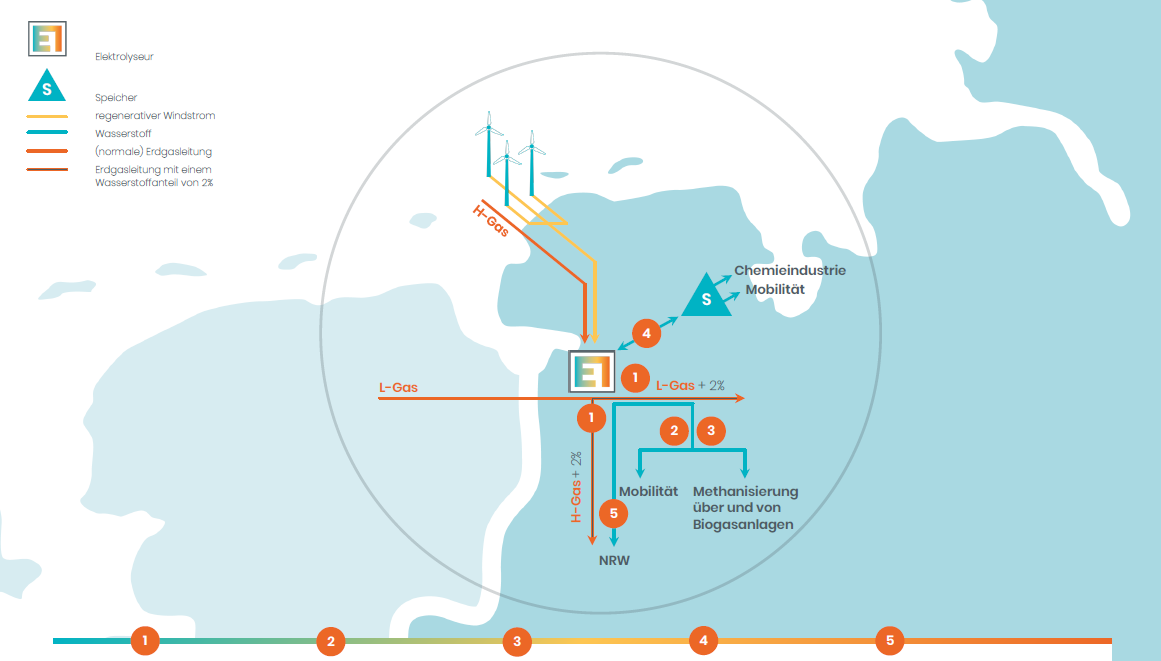Large German Power-to-Gas Unit Planned
adds remarks from Gasunie spokesman, in italics, commenting on behalf of the Element 1 partnership
Three Dutch and German network operators plan to build a 100-MW power-to-gas (PTG) pilot plant in the north German region of Lower Saxony to help stabilise the power grid and limit curtailment of wind energy.
The three investors TenneT, Gasunie Deutschland, and Thyssengas said October 16 it would be the largest plant of its kind in Germany if built in 2022. Potential sites are near TenneT substations at Diele and Conneforde that mainly collect and distribute offshore North Sea wind energy. TenneT runs much of the power grid in northern Germany plus all the high-voltage power grid in the Netherlands. The trio did not divulge cost, or which specialist will design and construct the unit, but have named the project as 'Element 1' (a reference to hydrogen's atomic number).
However a Gasunie Deutschland spokesman, on behalf of the Element 1 partners, said they anticipate investment needs in the "low three-digit million" [euro] range. He added that, although a contractor has not yet been selected, partners will carry out a feasibility study with technical details first that willlead to a specific location of the project.
With PTG, (sustainable) electricity is converted into hydrogen by 'electrolysing' water. Resultant hydrogen can then be either injected into a gas network, or sent to filling stations for use as a motor fuel. Alternatively the hydrogen can be ‘methanised’ - combined with carbon dioxide to produce a synthetic natural gas - also for injection into a gas network such as in the Ruhr region. Germany's Uniper and Gasunie have separately invested in small PTG pilot plants. 'Element 1' will incorporate both electrolysis and methanisation, the Gasunie spokesman added (see also chart below).
Gasunie in the Netherlands is partnering TenneT, Danish grid Energinet, and Port of Rotterdam in an initiative, yet to be developed, to establish ‘power link islands’ in the North Sea for the balancing and transmission of green electricity from offshore wind farm. From such islands, it could be sent to the mainland via power cables, and maybe also (using electrolysis) as hydrogen.
In June 2018, German power grid Amprion and its gas counterpart Open Grid Europe (OGE) announced they jointly want to build PTG plants in the 50MW-100 MW range in Lower Saxony or northern North Rhine-Westphalia. Amprion commercial director Hans-Jurgen Brick said that PTG plants to date in Germany have a maximum of 6 MW, which it and OGE want scaled up.
'Element 1' has been presented to German parliamentary state secretary for economy and energy Thomas Bareiss and Lower Saxony’s environment and energy minister Olaf Lies. But the investors’ statement did not say what financial support they might provide. Specialist engineering firms that have built PTG units to date include Sheffield-based ITM Power and Canada's Hydrogenics.
ITM Power last month said it is providing a UK-funded feasibility study for a 100 MW PTG unit at Runcorn , northwest England, on behalf of UK gas distributor Cadent and Engie-owned Storengy.
Dutch, German governments 'not doing enough'
Whereas Thyssengas which runs a German gas network is part-owned by Dutch investor DIF, both TenneT and Gasunie are Dutch state-owned. The Dutch government is under added pressure to decarbonise since a court ruled last week it was not doing enough to reduce global warming. The German coalition last year decided not to abide by a previously-set 2020 target to cut emissions.

Element-1 graphic courtesy of TenneT
Notes as follows, also from TenneT, translated from the German by NGW: 1) Injection (of 2% hydrogen into existing low- and high-calorific gas networks); 2) Delivery (of 100% hydrogen to primary target groups, such as H2 filling stations, or for methanisation of biogas facilities); 3) Methanisation (via biogas facilities); 4) Integration (use of storage caverns to hold larger volumes of H2 for use in the chemical and transport sectors); 5) Distribution (of 100% H2 into the hydrogen economy)



